Archive for the 'Uncategorized' Category
June 11th, 2023 by dave dorsey
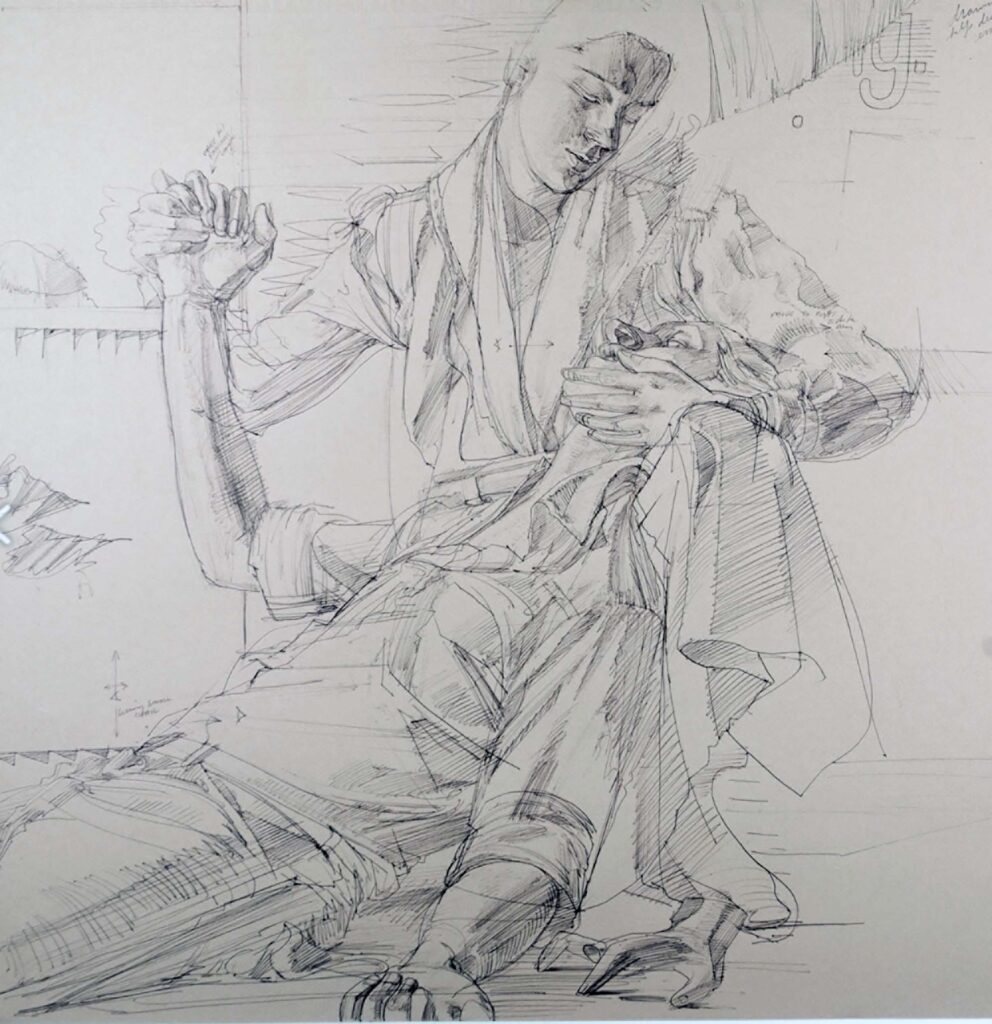
From the page of drawings at Jerome Witkin’s website. A sort of secular reworking of the Pieta. The masterful draftsmanship alone brings to mind the Renaissance, the emphasis on line, the hatch marks for shading, the immense assurance and the way form emerges so deftly at such a dramatic angle in the face of the figure who’s being held, the lips that hover there with such depth despite the paucity of information. And, when you stick with it awhile, you see what looks like Thing from the Addam’s Family having become sleek and clawlike, still scuttling across the floor.
June 9th, 2023 by dave dorsey
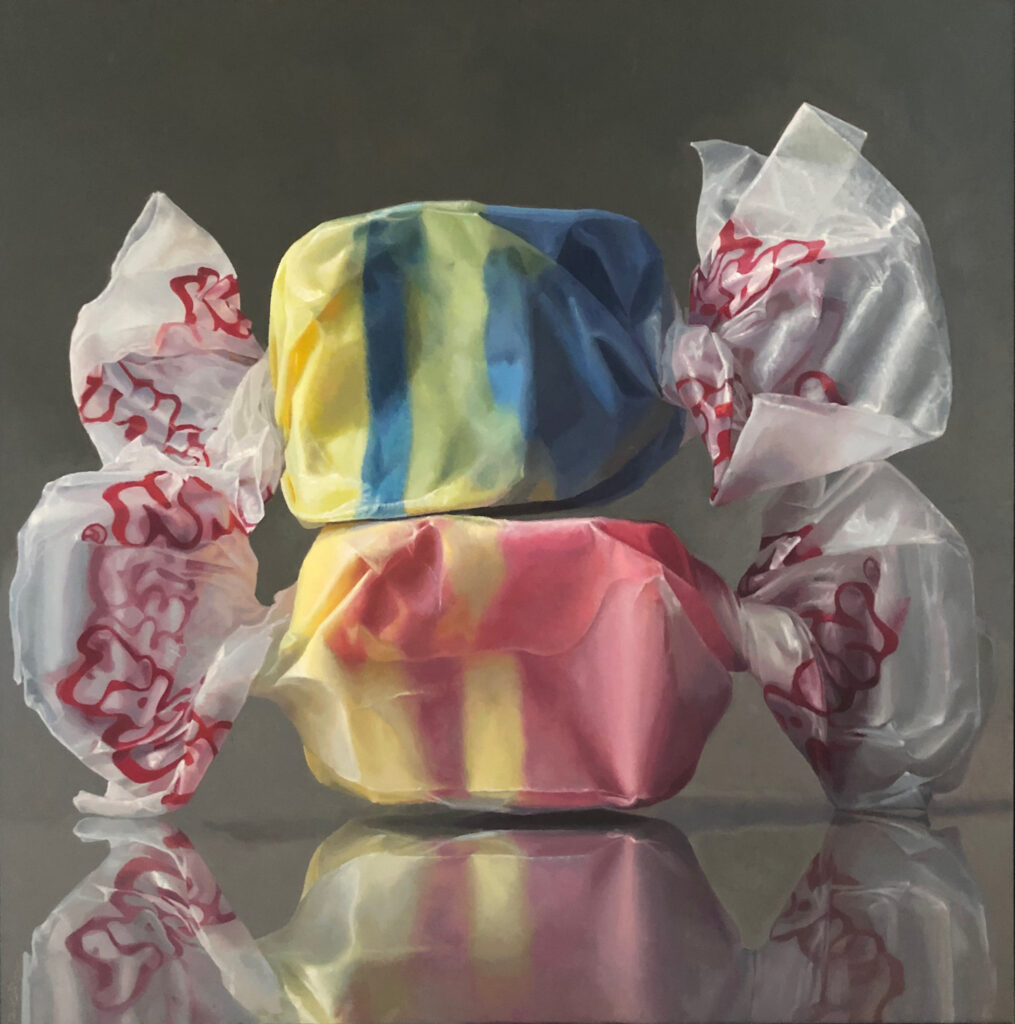
Yellow Zips, oil on linen, 46 x 46
Yellow Zips is on view at the Greenwich Art Society’s 106th Annual Juried Exhibition. It was purchased there last week.
May 14th, 2023 by dave dorsey
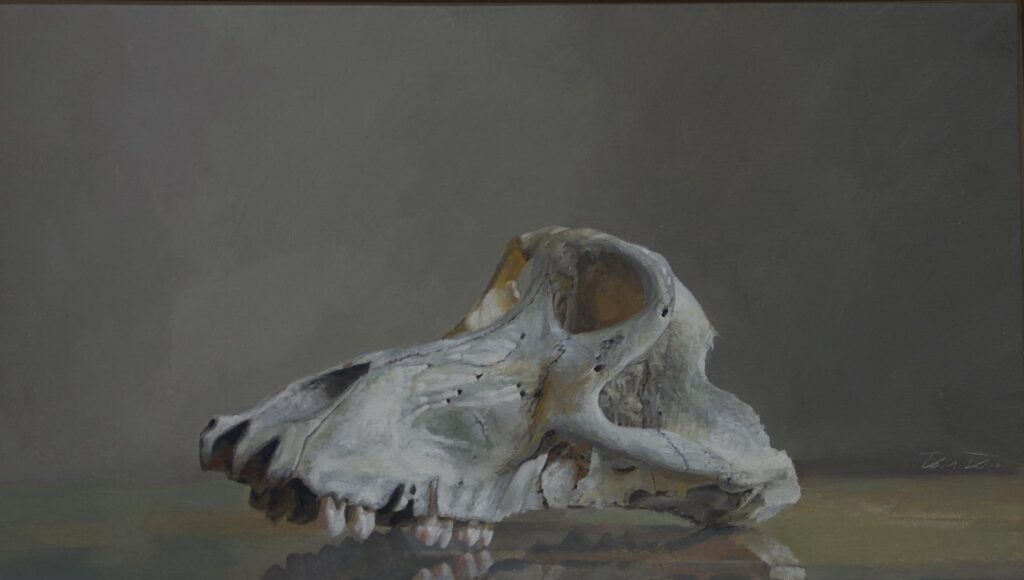
Baboon, Oil on linen, 18” x 30
Baboon, Oil on linen, 8” x 30 will is included in Art Biologic, Limner Gallery.
May 11th, 2023 by dave dorsey
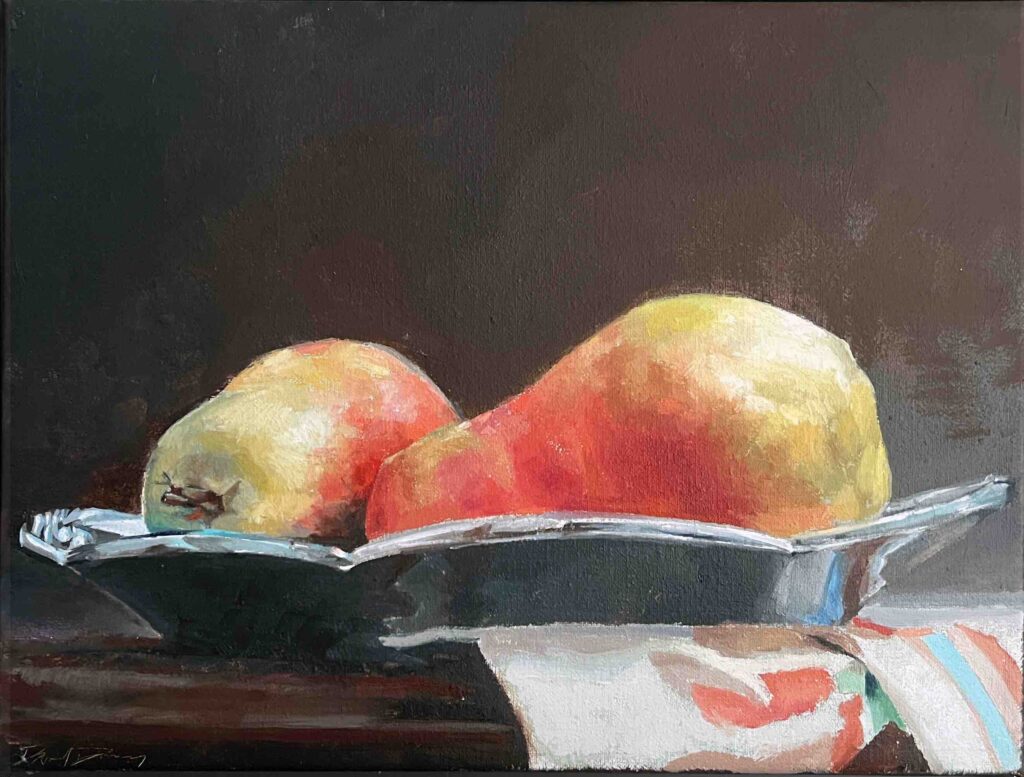
Two Pears, Oil on linen, 12 x 16
Two Pears, oil on linen, 12 x 16, is being shown at the 2023 Prague Biennial Art Exhibition, Capek Hall, Czech Republic. It’s a second version of one of the first paintings I ever contributed to a group show. The story of how it made its way through customs when it arrived near Prague could be the core of a small novella, but all’s well that ends well.
May 8th, 2023 by dave dorsey
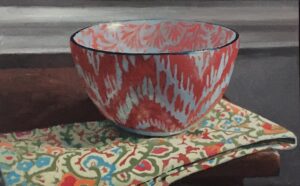
Patterns, Oil on linen, 10 x 16
Patterns, Oil on linen, 10 x 16, exhibited at 2023 National Juried Exhibition, Academy of the Arts.
May 5th, 2023 by dave dorsey
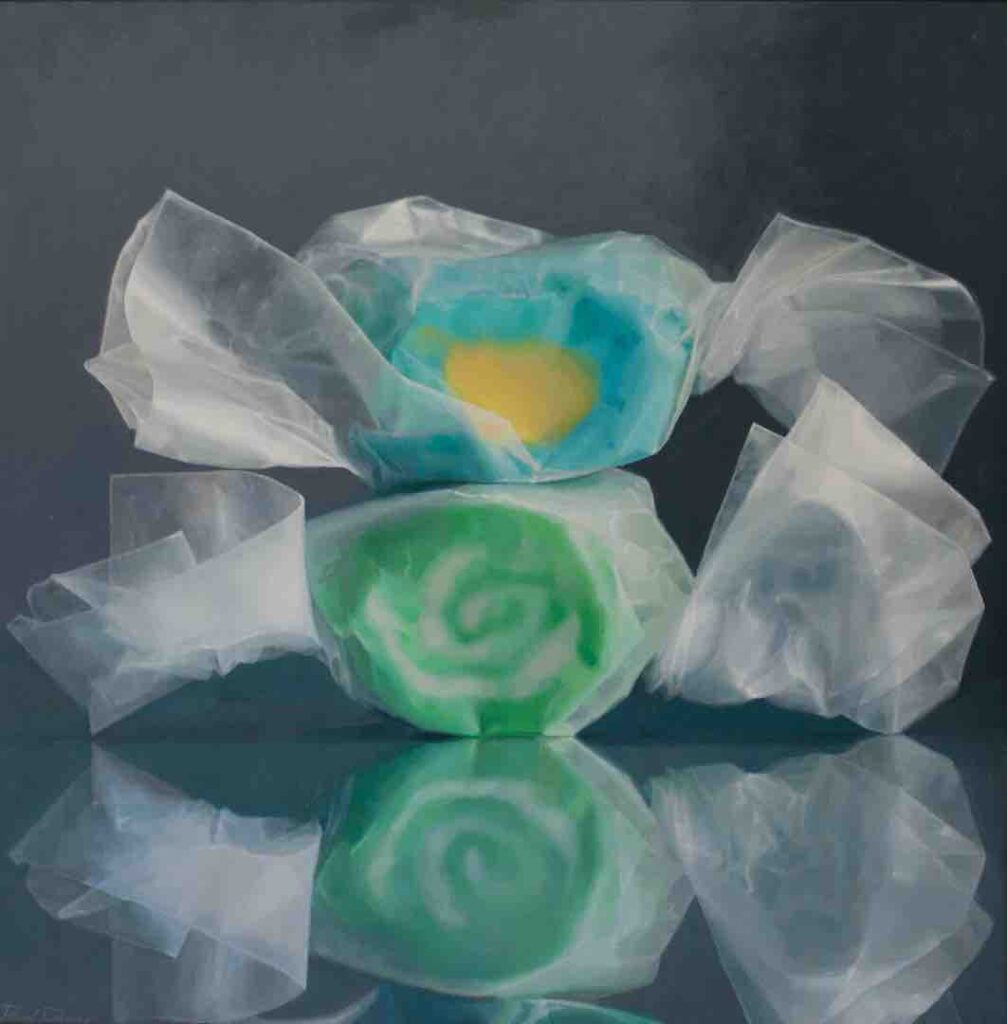
Sunny Sky, Green Furrows, oil on linen, 48 x 48
Sunny Sky, Green Furrows, oil on linen, 48 x 48 is included in Made in N.Y. 2023, at the Schweinfurth Art Center.
May 2nd, 2023 by dave dorsey
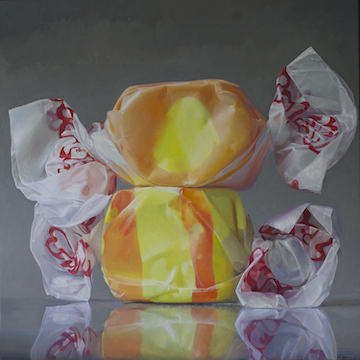
Happiness, oil on linen, 44 x 44
So far this year, I’ve contributed paintings to six different group exhibitions. This is the one closest to home. Happiness is included in the 68th Rochester-Finger Lakes Art Exhibition, Memorial Art Gallery. It will also be included in Manifest’s most recent International Painting Annual.
March 24th, 2023 by dave dorsey
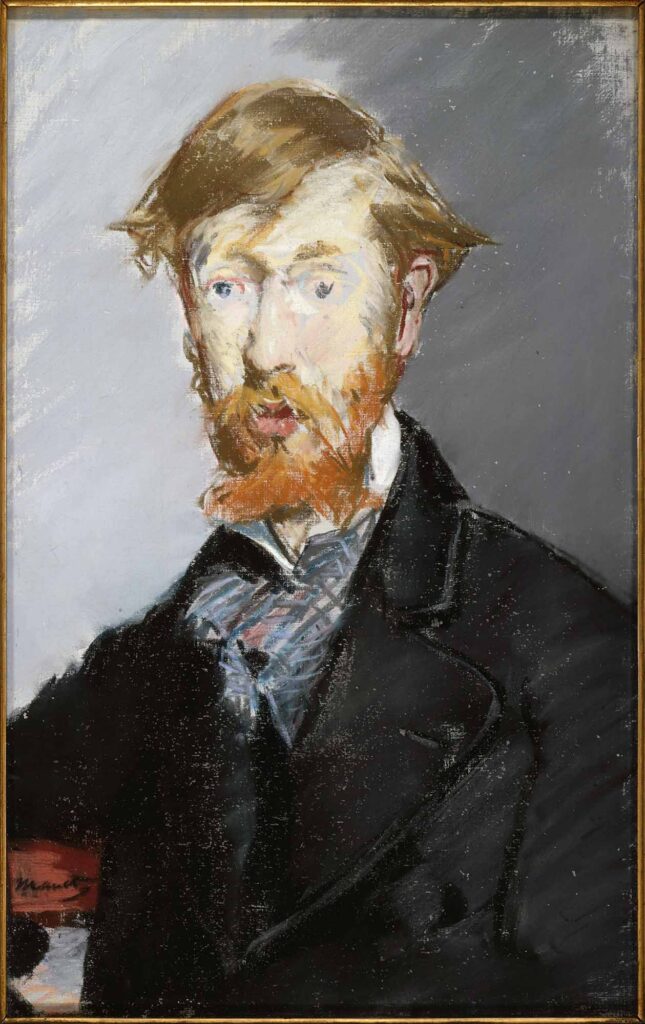
George Moore, pastel on canvas, 21 3/4 x 13 7/8 in.
Upcoming: Manet/Degas, September 24th, 2023 – January 7th, 2024, Metropolitan Museum of Art.
1
It’s probably reasonable to say Manet had a weakness for beautiful women, since he died of complications of syphilis. His weakness was also his strength. Women, especially attractive ones but not always, were the most compelling motif of his paintings and his perennial subject was the life, or lack of it, in their eyes. A naked woman’s glance toward her viewer became the core of the two paintings that established his reputation as the father of modernism: Luncheon on the Grass and Olympia. The scandal of the fact that the nudes in both paintings were probably also high-class courtesans, living off the generosity of their loyal sex partners (like Odette in Proust’s novel who rises to the highest ranks of Parisian society) announced Manet’s talent and deviously witty stance toward both the society and the artistic establishment of his day. The way he depicted the amoral world he saw in his high-class milieu looked transgressive to the arbiters of art. In reality, his paintings were good-humored satire on how modern life, as he experienced it, had little to do with the work being shown at the Salon exhibitions in Paris.
He was a truth teller with the heart of an outsider, and this outraged his contemporaries because in painting, nudity was expected to live within predictable narrative boundaries. In 1869, for example, Loudet’s interpretation of Cephalus and 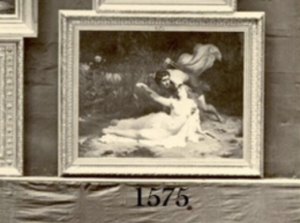 Procris hung on the walls of the exhibition, an accomplished painting within the acceptable guard rails: an interpretation of the Greek myth in which one could pretty much plead to having painted bare breasts under duress because it was required by a noble Greek myth. This workaround enabled what could have passed for soft-core porn to get into the Salon and be received with respect. Fragonard had painted a more prurient vision of the story, a typically amazing bit of Rococco painting from him, and it was a subject many painters reprised.
Procris hung on the walls of the exhibition, an accomplished painting within the acceptable guard rails: an interpretation of the Greek myth in which one could pretty much plead to having painted bare breasts under duress because it was required by a noble Greek myth. This workaround enabled what could have passed for soft-core porn to get into the Salon and be received with respect. Fragonard had painted a more prurient vision of the story, a typically amazing bit of Rococco painting from him, and it was a subject many painters reprised.
The nudity of Loudet’s painting was justified by the story-telling. Manet gently mocked the whole process of smuggling nakedness into the exhibition under the guise of noble or spiritual tropes. While structuring his images in ways similar to the presentation of unclothed women in the past, he showed his figures in contemporary settings, women being naked for no reason other than to be naked, or to make a living that way. If Olympia had been embraced by the critics, it might have become the first unapologetic centerfold of its time, but actually it’s not even as tamely erotic as Fragonard’s lush, seductively-lit work. It’s realistic, not titillating, and thus it’s a funny contrast to all the other heroic presentations of breasts. Manet was shamed for his wit. Like his contemporary, Flaubert, he created a kind of realism that at first served to epater le bourgeoisie until he began to use it to express some of the most fleeting and elusive moments in human life. Moments in life live on his canvases the way they do later in movies or in candid, “street” photography. His snapshots were precursors of Gary Winogrand and Vivian Maier. This was his magic: to trap life in flight, and watch it seem to move in place, a butterfly in a jar. Early on, as a result of his notoriety, he became friends with other kindred rebels, Baudelaire and Mallarme as well as the Impressionists, a group whose work he studied but whose esthetic he never completely adopted.
He didn’t really fit anywhere, except in the company of Degas, whose work advanced alongside his. Manet lurked around the edges of what was happening, studying and using some of it. He couldn’t give himself over completely to the Impressionist preoccupation with the pleasures of atmospheric color. It wasn’t the MORE
March 20th, 2023 by dave dorsey
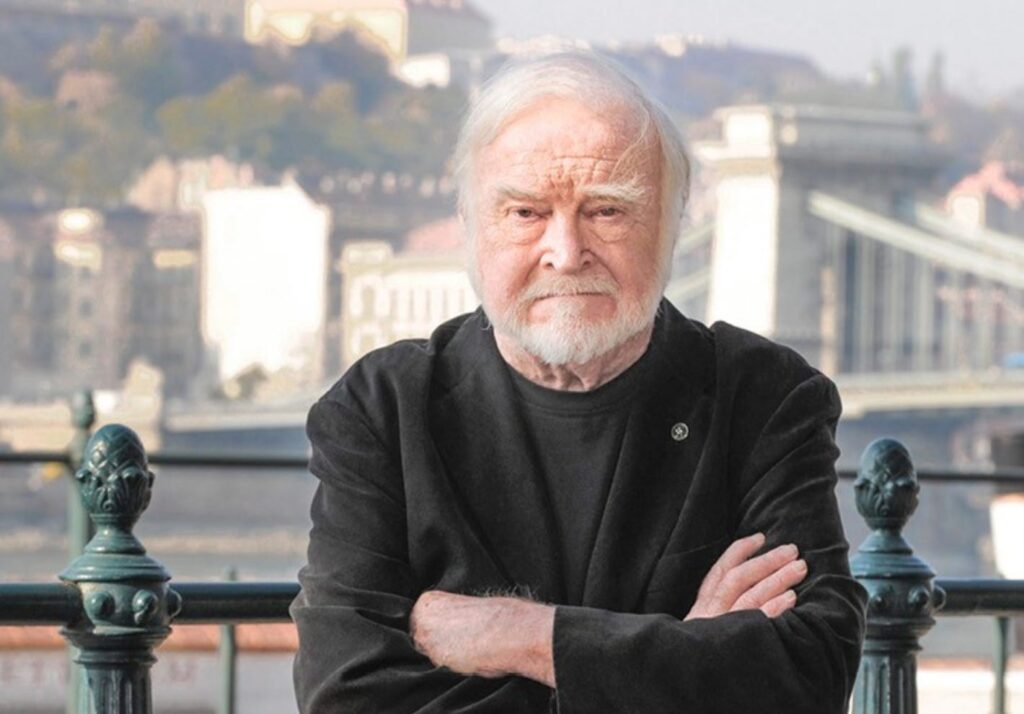
Mihaly Csikszentmihalyi, author of “Flow”, (1934-2021)
From the book Flow. The first quote describes probably the easiest, best justification for representational art, which is mostly about sustained attention for no motive but to pay attention and then acting on what it shows:
If you are interested in something, you will focus on it, and if you focus attention on anything, it is likely that you will become interested in it. Many of the things we find interesting are not so by nature, but because we took the trouble of paying attention to them. The second describes the transition from not-painting to painting on the average morning:
The optimal state of inner experience is one in which there is order in consciousness. … “Flow” is the way people describe their state of mind when consciousness is harmoniously ordered, and they want to pursue whatever they are doing for its own sake.
Most enjoyable activities are not natural; they demand an effort that initially one is reluctant to make. But once the interaction starts to provide feedback to the person’s skills, it usually begins to be intrinsically rewarding.
…success, like happiness, cannot be pursued; it must ensue…as the unintended side-effect of one’s personal dedication to a course greater than oneself.
…It is when we act freely, for the sake of the action itself rather than for ulterior motives, that we learn to become more than what we were.
Now . . . we do studies — we have, with other colleagues around the world, done over 8,000 interviews of people — from Dominican monks, to blind nuns, to Himalayan climbers, to Navajo shepherds — who enjoy their work. And regardless of the culture, regardless of education or whatever, there are these seven conditions that seem to be there when a person is in flow. There’s this focus that, once it becomes intense, leads to a sense of ecstasy, a sense of clarity: you know exactly what you want to do from one moment to the other; you get immediate feedback. You know that what you need to do is possible to do, even though difficult, and sense of time disappears, you forget yourself, you feel part of something larger. And once the conditions are present, what you are doing becomes worth doing for its own sake.
…success, like happiness, cannot be pursued; it must ensue…as the unintended side-effect of one’s personal dedication to a course greater than oneself.
March 17th, 2023 by dave dorsey
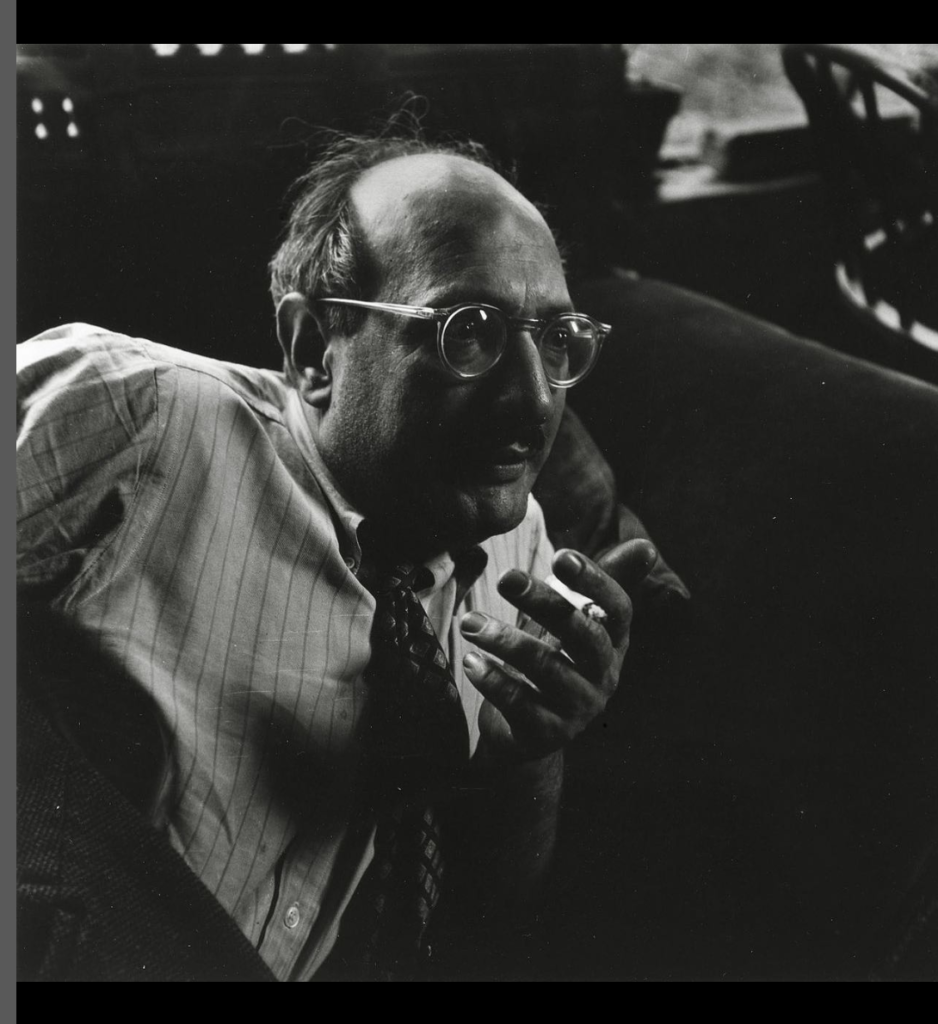
Some things have only intensified in the past 60 years. From the dailyrothko Instagram feed:
“When I was a younger man, art was a lonely thing. No galleries, no collectors, no critics, no money. Yet, it was a golden age, for we all had nothing to lose and a vision to gain. Today it is not quite the same. It is a time of tons of verbiage, activity, consumption. Which condition is better for the world at large I shall not venture to discuss. But I do know, that many of those who are driven to this life are desperately searching for those pockets of silence where we can root and grow. We must all hope we find them.”
– Address at The Pratt Institute, 1959
March 11th, 2023 by dave dorsey
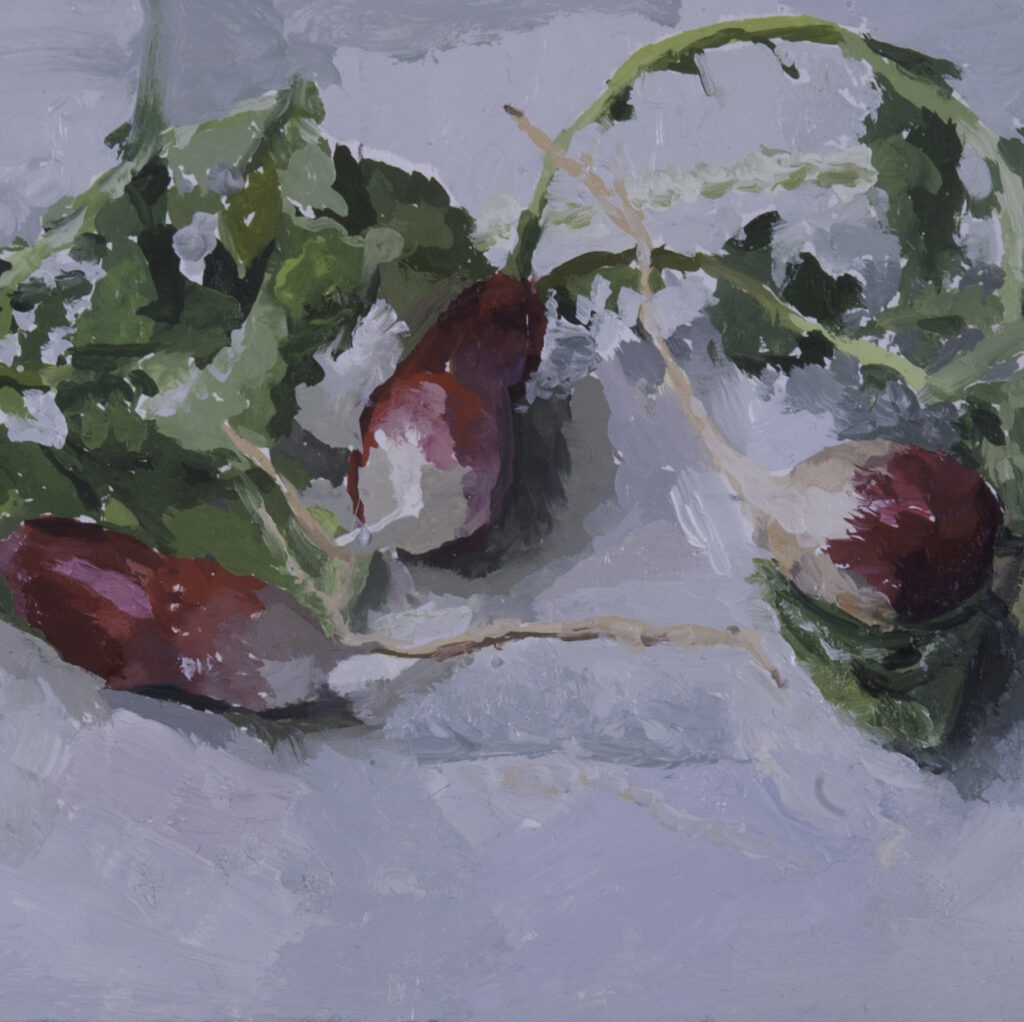
Four Radishes July, detail, 4 x 10 inches, oil on panel, 2015
March 8th, 2023 by dave dorsey
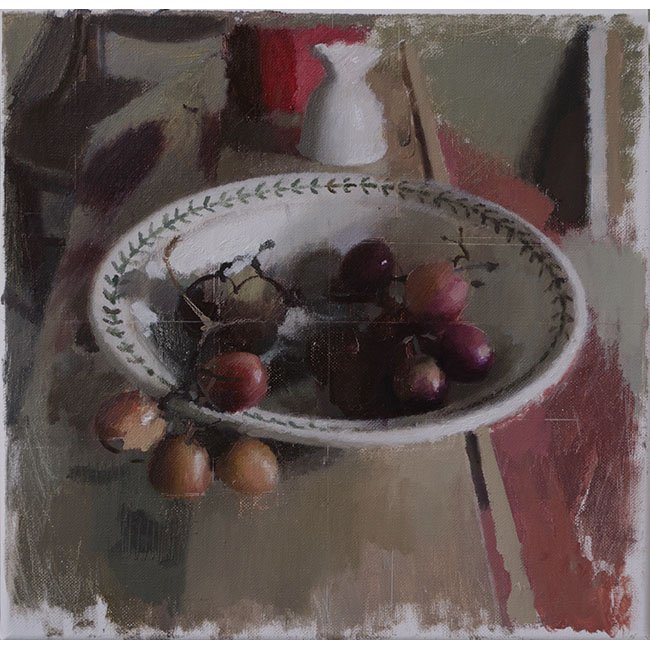
David Baird, Still Life with Grapes, 12 x 12, oil on canvas
I’ve been observing this painting for weeks now, off and on, trying to deconstruct what I’m seeing and why I love it. It does many things quite orthodox within the methods of the perceptual painters, some of them I “feel,” as one might say, and others I find irksome when they seem to become affectations and tics. He avoids everything irksome here even while engaging in a couple of the tics.
He’s another extremely talented alum of the Jerusalem Studio School, and he isn’t alone among painters who have studied there in that the quality of the paint he applies, for me, gives the sense of being mixed right from the tubes, without additional medium, so that it affords what seems like a dry, ragged texture, almost like pastel. The unfinished edges, which can seem like an affectation (one that I usually like until it looks studied), feel natural and serve his composition by echoing the tone of the bowl and the inverted soft-boiled egg cup—an object he has used repeatedly, going back to it the way Chardin kept using the same household tools from one painting to the next. That ragged border of raw canvas shows, in the gauzy and yet abrupt shift from paint to untouched canvas, what appears to be a low ratio of linseed oil to pigment. All of this sounds like shop talk, and I may be completely wrong about his mixing, but he is using this quality of paint to convey light and color in a way that’s deeply felt and sensuous. His tones are rich and beautiful and in perfect harmony. His very limited range of color is there to offer itself up for its own quiet virtues, not just to serve the purpose of representation.
Baird’s umber in the upper right corner, just leaning toward olive recedes obediently almost as negative space, a little glimpse of taupe wall that offers a ground for the objects closer to the viewer, but it’s also a hue that comes alive in juxtaposition with the reddish surface just below it that draws its harmonies from the grapes. Together, they are luscious colors that don’t call attention to themselves at first, but offer subtle pleasures to an insistent gaze. The geometry of this still life—the sphere, the rectangle of the MORE
March 5th, 2023 by dave dorsey
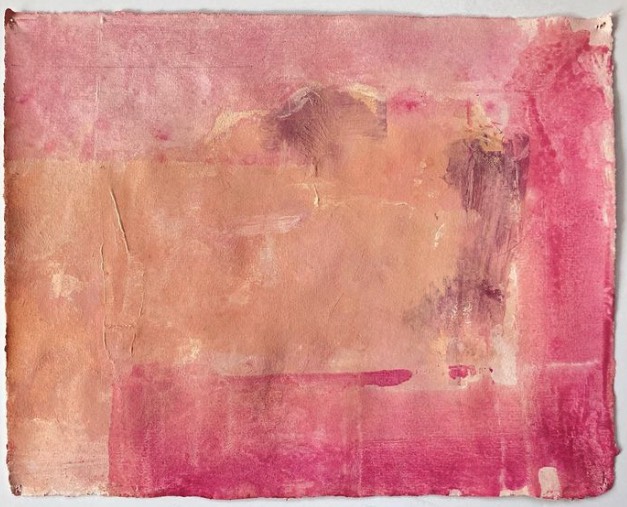
Stuart Shils, while traveling in ancient lands, rag paper, likely watercolor
The whole point of study… is to stand before the world in awe…
–www.stuartshils.com
I’ve been following Stuart Shils since I discovered him when he was juror for an annual group show five years ago at Prince Street in Chelsea. He’s one of the most consistently rewarding painters to follow on Instagram. He’s prolific as well, which makes him perfect for the ravenous maw of social media, but he’s able to keep the feed flowing with regular posts because much of his work is small and appears to be quickly executed, each painting seemingly just a freeze frame from an ongoing flow of paint. One of the aspects of his own Instagram stream that makes it unusual, if not unique, is that for a while it seemed to become a work of art itself, not just a way of sharing images of work done elsewhere: it was more or less the medium for his abstract photography. I could imagine buying a print of one of his photographs, but photography has been democratized to the point where it’s mostly digital now and exists in the ether as much as anywhere else, so when his shots appeared, they seemed to have their being there in that stream of images and nowhere else.
In those shots he was seeing the way he sees when he makes a painting: the photographs often had all the formal concerns and the feel for composition that magically give his paintings such a haunting quality of remembered immediacy, yearning and loss, shot through with a passion for color.
Most recently, he’s been proving that what he does may look like color field improvisation, but it’s also figurative in a broad sense: in extremely subtle ways, it represents the visible, physical world. It’s just as much about the ambiguous interplay of figure and ground as his earlier more quickly recognizable work. Lately, he’s using Instagram to create a diptych by pairing two paintings from twenty years apart, or thereabouts. In the earlier, one can usually recognize the image at a glance. In the more recent work, it takes a while to see how the gestural paint both reveals and conceals the figure. Often, it can take some extended looking to decipher what you’re seeing, or might be seeing. In the pairings, he offers one painting from around the turn of the current century and another from the MORE
March 2nd, 2023 by dave dorsey
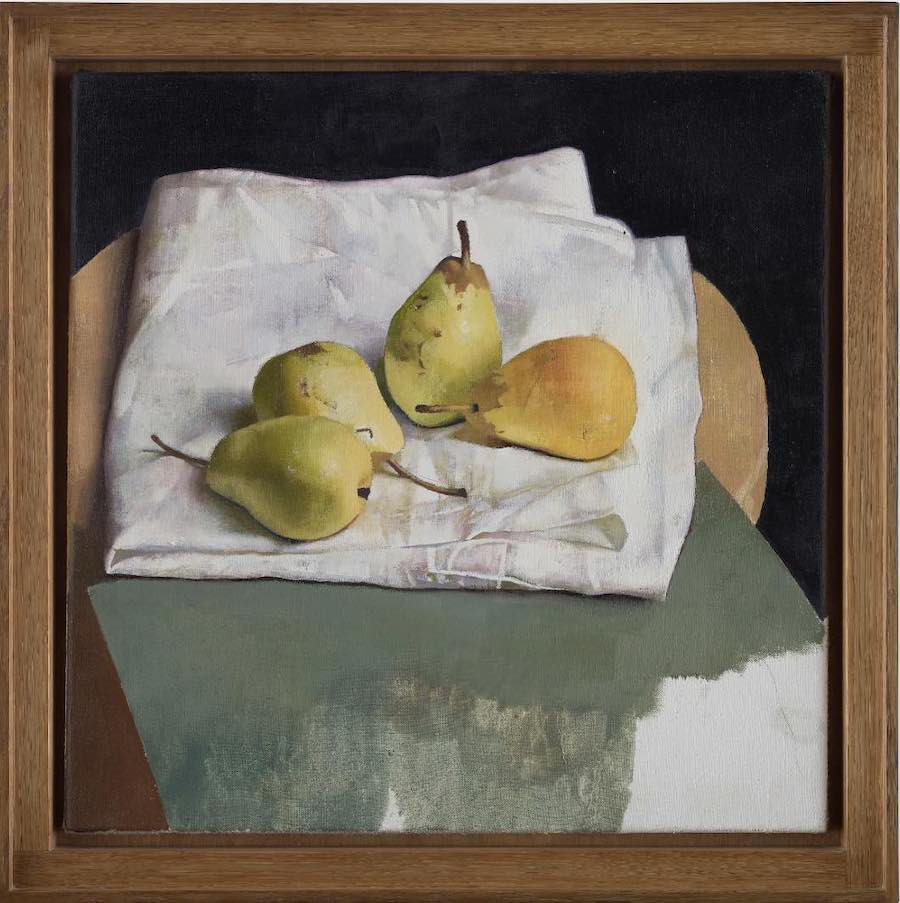
THE BAYEUX TAPESTRY, 2018, oil on linen, 15 3/4 x 15 3/4 inches
The unfinished quality of Kelley’s work is part of its appeal, especially when the untouched white canvas creates a balancing tension with the white cloth, though after a while with his paintings it begins to feel like an affectation. The fascination for me is how he gets that matte texture that seems to be everywhere, even when it’s evoking a gently shining pear. Four colors plus black and white. It’s as if he first applies Gesso a few times to raw canvas, and it’s so absorbent that it draws all the oil out of the paint leaving that luxuriant suede-like surface. The modeling of the cloth is a pleasure, as if he’s stenciling some of those creases and applying a mist of paint over them. The little white lines in the purplish bruise of shadow at the bottom of the cloth look like beetle trails in firewood. His titles can be even more recherche and quirky than Shils’.
February 27th, 2023 by dave dorsey

Fairfield Porter Field Flowers, Fruit and Dishes, 1974 Oil on masonite 18 × 22
Fairfield Porter’s work reached its apogee in the last decade of his life. By today’s standards, he died young, in his late 60s, but his work achieved a new level in those last years, a more photographic clarity, simplicity and balance that seemed to serve as a counterweight to the intentionally awkward-looking, sometimes primitive, way he handled paint. Yet at the same time, in his coastal scenes, he pushed the looseness as far as he could take it to a dazzlingly luminous near-abstraction. In both modes he surpassed much of what he’d done before, though his work all through the 60s was at a new level, as was Burchfield’s, though in a much different way and even more remarkably. Porter always wanted the paint to be what you saw, as much as de Kooning and Vuillard did, both of whom he admired, but in the more precise draftsmanship of that last period, he let you see what he was representing more clearly than ever before. He got out of the way: one hardly noticed how radically he simplified what he saw, eliminating all but the most necessary detail, and it went less noticed because his line was more photographic. In Portrait of Nancy Porter Strauss, The Tennis Game, House with Three Chimneys, Lizzie and Bruno, The Harbor–Great Spruce Head, Still Life 1975, and many others he distilled and refined what he had begun to do in the early 1960s, being bolder and brighter with his simplified areas of color, far more accurate in his line and embracing a realism less French, less Impressionist, harder-edged but, maybe ironically, more and more radiant. There were amazing harbingers of his late mastery, especially The Mirror, his homage to Las Meninas, but also in probably his most complex painting, the utterly controlled The Cove, a depiction of what is probably the Maine coast, one of his favorite subjects, but this time looking in toward the land, at low tide. A lone figure in khaki shorts picks his way across countless rocks toward shallow water. The way in which he simplifies without ever violating the actual look of that uneven littoral path, the muted color of the low mountains and pines, exactly the shift in value they require to indicate their distance, everything precise and not a single extraneous bit of paint applied anywhere–it pointed toward what he would be doing even more powerfully in the 70s. Meanwhile, the almost purely abstract, and paint-besotted, Calm Morning, in 1961, points toward The Ocean, a large square canvas that looks almost minimalist in the abstraction of its layered horizontal tiers of low whitecaps and the thin sheet of lilac tidewater washing back toward the ocean. It’s both uncannily accurate and yet seemingly loose, spontaneous and improvised.
There was a brief, insufficient piece in The Economist about five years ago about the notion of “the late, great work” of famous creative artists: Van Gogh, Beethoven, Ibsen, Goya. Proust died so young that his late work is really almost his only work, which is certainly true of Keats as well, so there’s a confusion at the heart of the thesis: are we talking old age or just the last act in a life of any duration? It’s funny the way the author sticks to its guns by citing work from the minds of those who were falling apart under stress and thus creating work that reflected the inner disintegration and/or withdrawal:
For each of these composers, late style meant something different. Gesualdo had murdered his wife and her lover, and spent his last days in a torment which one can sense in his crazily discordant late works. The emotional devastation of Schumann’s final days becomes starkly evident in his ruthlessly pared-down Gesänge der Frühe (“Songs of Dawn”). The Britten string quartet which Mr Biss has chosen shows the composer delighting in an extreme—and to him quite new—economy of expression. The chaotic middle movement of Mr Biss’s chosen Schubert sonata reflects the composer, who was dying of syphilis, going to pieces in rage and terror. Brahms’s late works suggest a man whose emotional energy has been sapped dry; Beethoven’s suggest the opposite. What links these composers, as Mr Biss points out, is that “with each of them, something has happened to completely change their style”.
Beethoven’s late quartets are indisputably awe-inspiring and maybe the best argument for the thesis that creative flourishing can take a lifetime to nourish. The list to support his thesis is fairly persuasive: the aforementioned Burchfield, Van Gogh, Porter, Matisse with his cut-outs, maybe whatever Stella will be doing before he dies, maybe Rembrandt, Degas, and certainly Monet. My takeaway: there’s hope for all of us who see the traces of youth shrink daily in the rear-view mirror.
February 24th, 2023 by dave dorsey
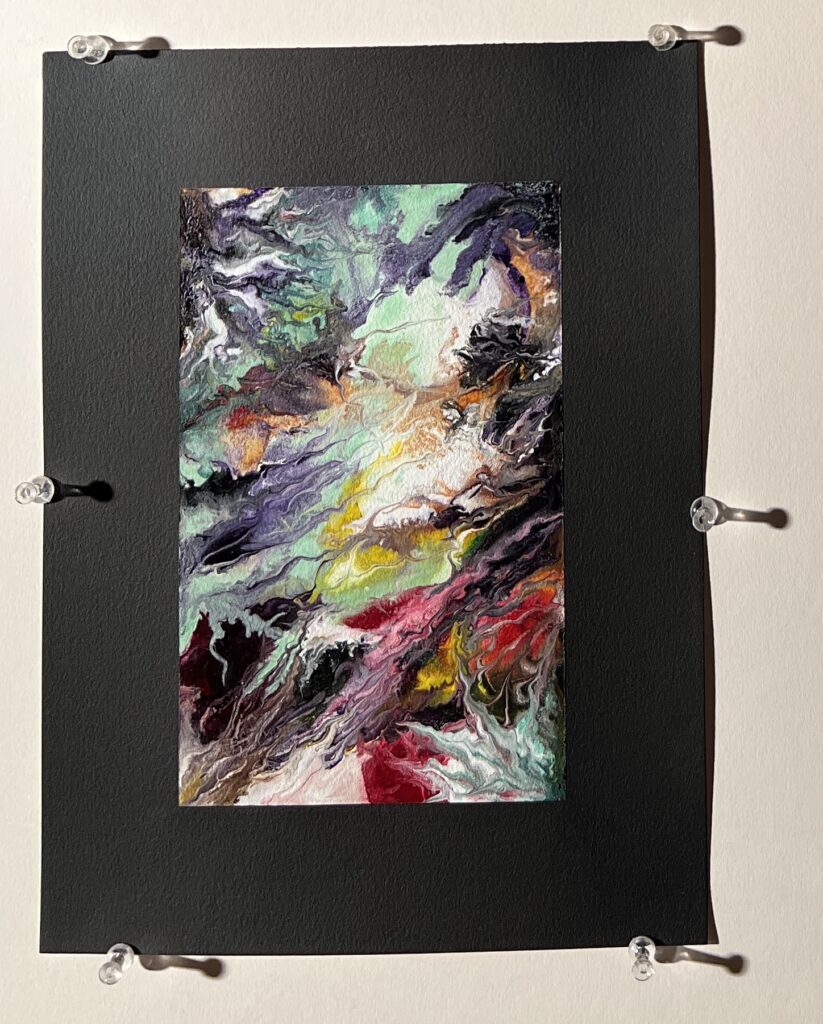
Another from Bill Santelli’s Reverie series, which for me brings his work to a new level, along with the In the Humming Air series. These very small pieces are entirely organic, though when he introduces geometric elements into this series, they create a grid that also feels new, compared to the tension between geometric and natural shapes in his previous work. The work feels natural and the imagery offers more little pings of recognition: hinting at light through trees or underwater, spaces that feel more outdoors than psychological. Love where it’s all going.
February 21st, 2023 by dave dorsey
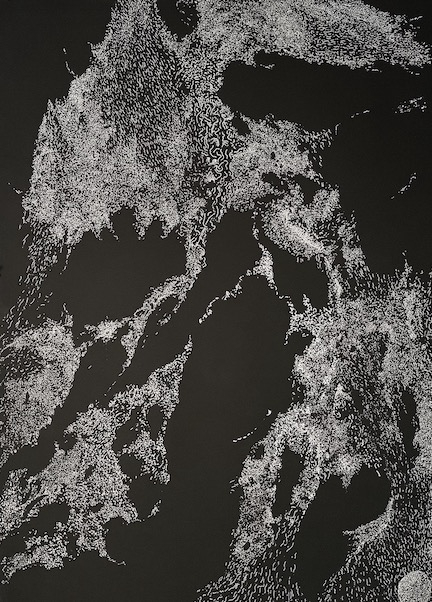
Bill Stephens has been doing something that strikes me as new, though he may not see it that way. He’s using fine-tipped pens to apply inks in varied colors to mixed-media paintings and, though extremely fine lines are his wheelhouse, the effect is different in the new work. There’s a jittery but shimmering quality to the almost pointillist throng of hatch marks in the new work. In his black and white drawings, the tiny white marks look like scratches applied to a black coat of paint on a white surface, but they are actually white ink, each mark one among what appear to be thousands that sweep across the surface like a murmuration of starlings or particulates 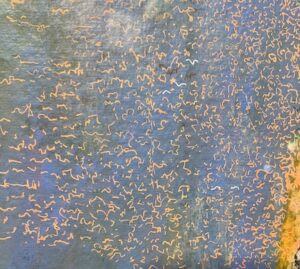 of smoke or very fine cloth swaying in a breeze. It gives the effect of seeing a massive migration through space, souls swept helplessly along in Dante, say, or just ants marching across sand. The shapes as a whole also look geographic or meteorological, seen from space. At the same time, Stephens is using different tiny marks, more like runes, in other brilliantly colored work, again colored inks against complementarily colored grounds in highly saturated tones. The effect is entirely different, more like the quality of light off a cathedral in Monet. In both modes, he’s capturing the febrile quality of awareness itself: constantly in flux, quiet and still and barely moving in the dark work, yet intensely alive and shimmering with a kind of static bliss in full color.
of smoke or very fine cloth swaying in a breeze. It gives the effect of seeing a massive migration through space, souls swept helplessly along in Dante, say, or just ants marching across sand. The shapes as a whole also look geographic or meteorological, seen from space. At the same time, Stephens is using different tiny marks, more like runes, in other brilliantly colored work, again colored inks against complementarily colored grounds in highly saturated tones. The effect is entirely different, more like the quality of light off a cathedral in Monet. In both modes, he’s capturing the febrile quality of awareness itself: constantly in flux, quiet and still and barely moving in the dark work, yet intensely alive and shimmering with a kind of static bliss in full color.
You can see this work at the current member show at Mill Art Center.
February 18th, 2023 by dave dorsey
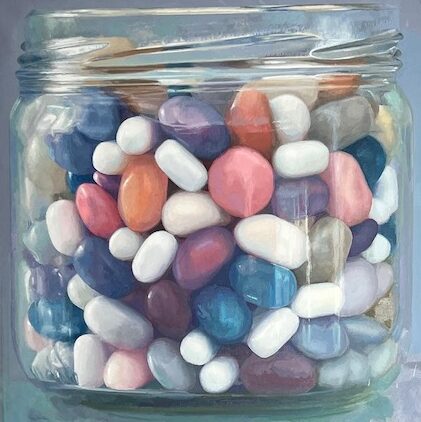
Candy Jar #13, oil on linen, 44 x 44
Candy Jar #13 has won Second Place in the Camelback Gallery’s online 2023 International Juried Painting Awards. A second candy jar painting was also included in the exhibition as a finalist.
February 15th, 2023 by dave dorsey
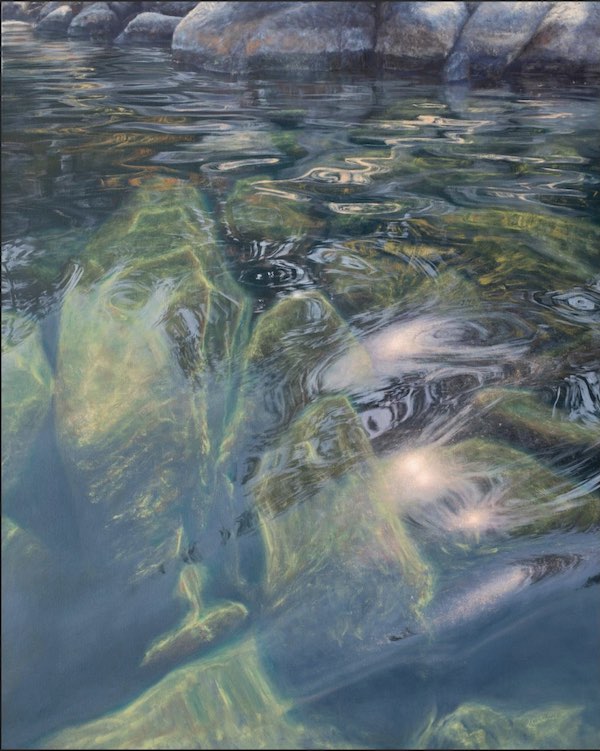
Irina Cumberland, Stone Warm, oil on copper
From today through the 19th, Arcadia Contemporary is offering what is essentially an international survey of representational art from 13 different countries at the L.A. Art Show. The catalog for work available from this one gallery is astonishing. The Arcadia booth is nearly an entire exhibition in itself. The range of work is purposefully narrow in one sense, driven by Arcadia’s adherence to the dictates of its own largely dark, figurative esthetic, but I was dumbfounded by the sheer number of artists and variety of work, the way Arcadia has located, in so many different places around the world, exactly the sort of painter it chooses to represent. The Arcadia catalog rivals the international painting annuals produced by Manifest Gallery, with over 500 pages of artwork offering around 200 paintings and drawings. It’s an impressive act of curation and offers what must be the fruit of endless research to locate exactly the sort of painter the gallery seeks from Korea, Nigeria, United Kingdom, United States, Spain, Israel, France, Cuba, Japan, Australia, Russia, Ukraine, Spain, and Poland.
When I last visited the gallery in SoHo, Steve Diamant showed me his most recent discovery, one of the paintings in this show from a female Russian painter he’d recently discovered. He said he almost always seeks out the artists he shows, not the other way around, without divulging exactly how he tracks painters who fit into the gallery’s esthetic. It’s a category of work hard to pin down precisely because it depends on his own individual sensibility. There’s just a touch of Weimar Republic in some of this work, the mordant air of the cabaret. But he also shows bright, ecstatically affirmative almost wholesome paintings of simple, familiar things and situations from painters whose vision is anything but sceptical. He said the work he wants is frequently beautiful but never pretty, though some work in his catalog could be considered quite pretty—except that the adjective seems to have joined sweet and nice in a ghetto of paradoxical pejoratives. (Wait long enough and someone will start a Make Pretty Great Again movement.) All of which is to say the work he selects is often visually and morally or emotionally dark, limited in its range of color, often nearly monochromatic. What a few of his artists depict verges on the decadent, even depraved, and there’s a theatrical and implicitly narrative quality to what he likes, something he prefers to call cinematic. Staged drama would be my description, and clearly some of the work is painted from scenes with models costumed and posed for the painting, with all the drawbacks and all the undeniable impact of that kind of artifice. Frequently, the images imply a backstory through these posed, stylized subjects, and some work verges on illustration or fashion shots, yet most of the paintings remain challenging because they almost always have a quality Gaston Bachelard called oneiric—being both real and unreal at the same time, sometimes hyper-real, but in a way that tips the portrait or scene beyond the range of mundane daily experience into a slightly disquieting state of surreal or haunted dream. That pretty little girl in bright colors has a lizard on her shoulder. There are bees gyrating around the flower in another girl’s hand. The rugged and handsome older man with the gray mane has a stiletto pump aimed at his nose like a gun. That quaint little town has a massive tornado approaching from the distance. The roller coaster is, hm, well it’s on fire! Much of this work feels equal to the eschatological mood that seems to be the dominant tone of the media about nearly everything now: the world just keeps either dying or ending, if you watch the news often enough. Yet the tone of the work Arcadia shows is quietly poised just this side of its own existential dread, balancing there, the way Hopper did with the subject of loneliness in his single figures in urban, dense populations.
In this vein, the work that least appeals to me, in terms of my personal taste, but most impressed me in the way its conscious limitations give it power is from another Russian: Alexander Timofeev. Like so much of what Diamant selects, his color is so muted as to be almost absent, but in his cropped images of faces, the moribund skin tones are perfect for the warped, moral universe on display. At a different level, his paintings read like a gallery of the vices, but without Giotto’s clear delineation of one vice from the next in his own Early Renaissance sequence. The most stunning one, Secret, shows two women, one gazing up with addicted desire at a glittering clutch purse, dangling by its strap from the hand of the other witch-like figure. The temptress is dressed in a red robe (a robe that reappears in another painting, Slave ,of someone smothering the head of a man, visible in relief through the red fabric that wraps around his head like molten plastic pressed onto a mold of a face). It’s a world as weird as Macbeth, as morally ill as the Marquis de Sade, and yet the remarkably detailed realism in the faces and hair transcend allegory, reminding one of Christian Seybold’s 18th century portraits, even though these are far darker in spirit and tones. Yet, the context for all of them is established in the title of the catalog’s penultimate painting, The Tenth Commandment, a simple image of an older man’s hand grasping the limp wrist and hand of a very young woman, who in her submission appears to be either dazed or drugged.
Dark in imagery, but completely different in spirit and worldview, are Stephen Fox’s marvelous night scenes of drive-in movie screens beneath a sky during an electric storm. The convergence of what is essentially a screen capture of Darth Vader in The Empire Strikes Back with illuminated storm clouds over the pines that flank the screen and the audience of people sitting in front of their cars at night: the scene is irresistible and breath-taking, partly because the expansive Romanticism of the image gets undercut by the irony of juxtaposing a big rectangle of luminous pop culture that looks trivial against nature’s infinite sublimity. The effect is to make what’s depicted feel like an image of the perfect family night out: summer warmth, lightning and thunder without any rain, a fantastic movie, civilization having reached a sort of apogee of balance between old-school film projection, CGI, a population with leisure time on its hands and the loveliness of nature itself, all of it painted with astonishing skill. You look at Fox’s paintings and think we aren’t such a terrible species after all and the world has never been a better place to be.
Matthew Cornell’s two contributions to the catalog are just as beautifully done as always, but these two scenes are more enigmatic than his previous ones, which were often painted during the “golden hour” after sunset, before dark. These are at night, little structures with a single light shining down, painted in a way that looks a bit looser than in the past, until you realize they are only eight inches wide. The tiny scale demands more generalized brushwork. One has a more consciously imaginative touch: a second glance at that one-way sign behind the windowless building and you realize it says Hope. These tiny paintings are one of Arcadia’s signatures: the smaller the work, more he’s interested. Diamant has assembled here some of the miniature work he regularly exhibits and sells. For example, Stephen Mackey’s fey oil-on-panel portraits of rodents dressed as infants in frilled collars are only three inches square. It’s hard to imagine smaller artwork, other than of course sculptures inside the eyes of needles.
Cuban artist Darian Mederos contributes portraits of sensuous female faces, eyes closed and alluring, but he lets you view them through bubble wrap. The distortion it affords would seem gimmicky and coy, as if to suggest you’re spying on these sultry women though a wall of warped glass blocks, imaginatively completing the picture on the other side, until it’s clear the regularity of the grid created by the bubbles points back to Chuck Close with his later grid paintings and Alyssa Monks, when she was doing portraits of faces seen through droplets of water on glass. It’s a balancing act between soft porn and a simple exploration of a different way to examine how visual perception works. Plus, of course, a smart way to recycle all that surplus bubble wrap left over from shipping artwork to collectors and fairs.
In a completely different mode, with the most emotionally upbeat work in the catalog, Tim Rees depicts women, some solitary, others with a child in their arms, as well as a Norman Rockwell-esque boy in pants and loose suspenders, standing at low tide along the ocean or the Gulf. The scenes are lovely, one might be so bold as to say even extremely pretty, with low sunlight, sometimes at sunset, but without any of the kitsch sentimentality, or at least Pre-Raphaelite drama usually inevitable with paintings of beautiful women standing near water. These are simple, realistic transcriptions of what’s already beautiful and casually, accidentally wonderful in and of itself in daily life, full of light and color, a sharp departure from what would seem the Arcadia creed but perfectly at home with the rest of the work in the quality of its vision and execution.
The most abstract of the paintings are also at least as hyper-realistic as the most detailed work in the show, the swirling, undulating essentially color-field compositions of Irina Cumberland, one of the gallery’s Ukrainian painters in the show. Her large oil-on- copper paintings capture the dance of light on what would appear to be rippling tropical water. Paintings of light on water are plentiful, if you search for them, but these are carefully composed in such a way that they may be the best and most lyrical I’ve ever seen. Stone Warm is a fantastic abstraction: blues, violets, greens, and yellowish olives swirl in unpredictable ways, reverberating toward the top of the canvas, erupting from beneath, all of it balanced and yet in constant motion. It’s an amazing painting, the sky reflected in such a way that you can’t quite recognize anything in the water until you notice and realize that the row of huge river stones along the top of the canvas anchor the image in reality, snap it back from abstraction. What a joy it must be to paint these canvases: what must be weeks of arduous, painstaking accuracy leading up to the way in which the finished painting seems a perfect image of spiritual liberation.
February 12th, 2023 by dave dorsey
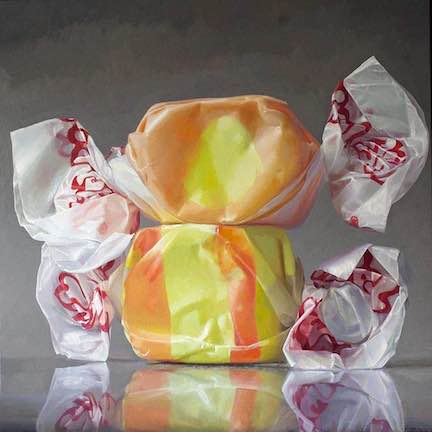
Happiness, oil on linen, 46 x 46
I was pleased that Happiness, from my series of salt water taffy paintings, was invited to be a part of the biennial 68th Rochester-Finger Lakes Exhibition at the Memorial Art Gallery. It will also be included in the new International Painting Annual published by Manifest Creative Research Gallery. I’ve been included twice before but it has been a few years. It will be a pleasure to see it keeping company with the work of the other artists selected this year.








 Procris
Procris








 of smoke or very fine cloth swaying in a breeze. It gives the effect of seeing a massive migration through space, souls swept helplessly along in Dante, say, or just ants marching across sand. The shapes as a whole also look geographic or meteorological, seen from space. At the same time, Stephens is using different tiny marks, more like runes, in other brilliantly colored work, again colored inks against complementarily colored grounds in highly saturated tones. The effect is entirely different, more like the quality of light off a cathedral in Monet. In both modes, he’s capturing the febrile quality of awareness itself: constantly in flux, quiet and still and barely moving in the dark work, yet intensely alive and shimmering with a kind of static bliss in full color.
of smoke or very fine cloth swaying in a breeze. It gives the effect of seeing a massive migration through space, souls swept helplessly along in Dante, say, or just ants marching across sand. The shapes as a whole also look geographic or meteorological, seen from space. At the same time, Stephens is using different tiny marks, more like runes, in other brilliantly colored work, again colored inks against complementarily colored grounds in highly saturated tones. The effect is entirely different, more like the quality of light off a cathedral in Monet. In both modes, he’s capturing the febrile quality of awareness itself: constantly in flux, quiet and still and barely moving in the dark work, yet intensely alive and shimmering with a kind of static bliss in full color.

